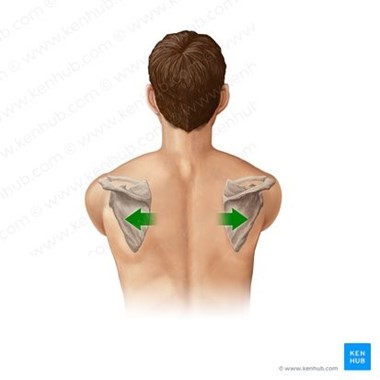Identify the anatomical movement illustrated below and state the joint involved (for example flexion of the knee joint).

The Correct Answer is ["Scapula protraction at the scapulothoracic joint."]
Scapula protraction refers to the movement of the shoulder blade (scapula) away from the spine, toward the front of the body.
This movement is also known as scapular abduction or anterior scapular tilt.
The joint involved in scapula protraction is the scapulothoracic joint, which is not a true joint, but rather a functional joint formed by the articulation between the scapula and the thorax.
The scapula is a flat bone that glides over the back of the ribcage, allowing for a wide range of movements of the arm.
Other movements of the scapulothoracic joint include:
Scapula retraction: This refers to the movement of the shoulder blade towards the spine, away from the front of the body.
This movement is also known as scapular adduction or posterior scapular tilt.
Scapula elevation: This refers to the movement of the shoulder blade upwards towards the ears.
This movement is also known as the upward rotation of the scapula.
Scapula depression: This refers to the movement of the shoulder blade downwards towards the feet.
This movement is also known as a downward rotation of the scapula.
Scapula upward tilt: This refers to the movement of the upper border of the shoulder blade upwards, towards the head.
This movement is also known as superior scapular rotation.
Scapula downward tilt: This refers to the movement of the upper border of the shoulder blade downwards, towards the feet.
This movement is also known as inferior scapular rotation.
All of these movements are important for proper shoulder function and are necessary for a wide range of daily activities, such as reaching, lifting, pushing, and pulling.
Nursing Test Bank
Naxlex Comprehensive Predictor Exams
Related Questions
Correct Answer is A
Explanation
The cervical vertebrae are the only vertebrae that have transverse foramina, which are openings in the transverse processes that allow the passage of the vertebral arteries and veins.
Choice B is incorrect because lumbar vertebrae do not have transverse foramina.
They have large bodies and short, thick transverse processes that serve as attachment sites for muscles.
Choice C is incorrect because thoracic vertebrae do not have transverse foramina.
They have costal facets on their transverse processes that articulate with the tubercles of the ribs.
Choice D is incorrect because sacral vertebrae do not have transverse foramina.
They are fused together to form the sacrum, which has four pairs of sacral foramina on each side that transmit sacral nerves and vessels.
Correct Answer is ["Acetabulum"]
Explanation

acetabulum is the concave cavity located on the lateral surface of the hip bone.
It is formed by the fusion of the ilium, ischium, and pubis bones.
The acetabulum articulates with the head of the femur to form the hip joint, which is a ball-and-socket joint that allows for a wide range of movement.
The acetabulum is lined with articular cartilage, which provides a smooth surface for the head of the femur to move against.
The acetabulum is also surrounded by a fibrocartilaginous ring called the acetabular labrum, which deepens the socket and helps to stabilize the hip joint.
Injuries to the acetabulum can result in hip dislocations or fractures, which can be very painful and require medical intervention.
Whether you are a student looking to ace your exams or a practicing nurse seeking to enhance your expertise , our nursing education contents will empower you with the confidence and competence to make a difference in the lives of patients and become a respected leader in the healthcare field.
Visit Naxlex, invest in your future and unlock endless possibilities with our unparalleled nursing education contents today
Report Wrong Answer on the Current Question
Do you disagree with the answer? If yes, what is your expected answer? Explain.
Kindly be descriptive with the issue you are facing.
